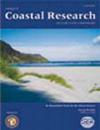Climate Change Impacts on Entrance Processes of Intermittently Open/Closed Coastal Lagoons in New South Wales, Australia
4区 地球科学
Q3 Earth and Planetary Sciences
引用次数: 28
Abstract
HAINES, P.E. and THOM, B.G., 2007. Climate change impacts on entrance processes of intermittently open/closed coastal lagoons in New South Wales, Australia. Journal of Coastal Research, SI 50 (Proceedings of the 9th International Coastal Symposium), 242 – 246. Gold Coast, Australia, ISSN 0749.0208. Intermittently open/closed coastal lagoons are a relatively unique feature of the south-east Australian coastline, and NSW in particular. Future climate change is expected to modify a number of climate variables that define the physical and chemical structure and ecological behaviour of the NSW coastal lagoons. These climate variables include mean sea level, wave climate and rainfall behaviour (total depth and storm intensity). Entrance morphodynamic processes are particularly vulnerable to climate change. These processes, which describe the opening and closing cycle of these lagoons, are controlled by dominant coastal (wave and sea level) conditions and episodic catchment runoff events. The magnitude of entrance impacts will depend on the particular characteristics and location of individual lagoons. An increase in mean sea level is likely to move the entrance sand berm upward and landward. An increase in south-easterly waves will cause minor rotations in beach planform alignments with expected net erosion from southern ends of beaches and net accretion at northern ends. For lagoon entrances at the southern end of beaches, this will result in a net loss of sand from the entrance and a shortening of the entrance channel. For lagoon entrances at the northern end of beaches, this will result in a net growth of the entrance berm, possibly offsetting the recession resulting from mean sea level rise. Increased typical lagoon water levels behind the berm are also expected. Marine flood tide deltas may accrete vertically and more landward. A decrease in total rainfall depth is likely to retard the cycle of filling and draining, and reducing the frequency of entrance breakout for mostly closed lagoons. For mostly open lagoons, however, an increase in rainfall storm intensity may actually increase scour through the entrance, thus increasing the longevity of ocean connections.气候变化对澳大利亚新南威尔士间歇性开放/封闭沿海泻湖入口过程的影响
HAINES, P.E. and THOM, B.G., 2007.The ocean and the ocean of the marine ocean.The Ocean Observations of the Ocean Observations in New South Wales, Australia, ISSN.澳大利亚黄金海岸,ISSN 0749.0208。间歇性开放/封闭的沿海泻湖是澳大利亚东南海岸线,特别是新南威尔士州的一个相对 独特的特征。预计未来的气候变化将改变一些气候变量,这些变量决定了新南威尔士州沿海泻湖的物理、 化学结构和生态行为。这些气候变量包括平均海平面、海浪气候和降雨行为(总深度和风暴强度)。入口形态动力学过程特别容易受到气候变化的影响。这些过程描述了这些泻湖的开放和关闭周期,受主要沿岸条件(波浪和海平面)和偶发的集水径流事件的控制。入口影响的大小取决于各个泻湖的具体特征和位置。平均海平面上升可能会使入口沙堤向上和向陆地移动。东南方向海浪的增加会导致海滩平面线形的轻微旋转,预计海滩南端会出现净侵蚀,而北端则会出现净增生。对于位于海滩南端的泻湖入口,这将导致入口处沙子的净流失和入口通道的缩短。对于海滩北端的泻湖入口,这将导致入口护堤的净增长,可能会抵消平均海平面上升造成的退缩。预计护堤后的典型泻湖水位也会上升。海洋洪潮三角洲可能会垂直并更向陆地延伸。总降雨深度的减少可能会延缓填湖和排水的循环,并降低大部分封闭泻湖的入口突破频率。然而,对于大部分开放式泻湖而言,暴雨强度的增加实际上可能会加剧入口处的冲刷,从而延长与海洋连接的时间。
本文章由计算机程序翻译,如有差异,请以英文原文为准。
求助全文
约1分钟内获得全文
求助全文
来源期刊

Journal of Coastal Research
地学-地球科学综合
自引率
0.00%
发文量
87
审稿时长
3-8 weeks
期刊介绍:
The Journal of Coastal Research (JCR) is one of the leading international journals for coastal studies and processes, and is published bi-monthly by the Coastal Education & Research Foundation [CERF]. By covering the entire field of coastal research, the JCR encompasses all subjects relevant to natural and engineered environments (freshwater, brackish, or marine) and the protection/management of their resources in the vicinity of coastlines of the world. Even though the journal broadly focuses on immediate shoreline zones, the JCR also embraces those coastal environments that either reach some indefinite distance inland or that extend seaward beyond the outer margins of the sublittoral (neritic) zone. The JCR disseminates accurate information to both the public and research specialists around the world on all aspects of coastal issues in an effort to maintain or improve the quality of our planet''s shoreline resources.
 求助内容:
求助内容: 应助结果提醒方式:
应助结果提醒方式:


